
Are you feeling overwhelmed by all your current projects and the thought of getting them done? Struggling to keep track of everything that must be accomplished and when?
To rid you of these troubles, we have compiled a comprehensive list of 20 project management tools and techniques that will help you to streamline your workflow and boost productivity.
We’ve scoured the internet to find the most cutting-edge technologies and management trends to ensure you stay ahead of the game. From Agile and Waterfall to Gantt charts and Kanban boards, this article will provide you with a plethora of options to choose from based on your specific project needs.
So, let’s dive right in!
Traditional Project Management Methodologies
Traditional project management is ideal for projects that follow a step-by-step approach. Unlike other methodologies, it emphasizes linear processes, upfront planning, and prioritization, resulting in set timelines, budgets, and requirements.
The advantages of traditional methods include well-defined goals, controllable processes, well-documented progress, and impeccable accountability.
Now, let’s explore traditional project management approaches a bit deeper.
1. The Waterfall Model
The Waterfall approach is a systematic and sequential way to manage projects. It involves clearly defining and documenting project requirements, followed by a step-by-step execution process until completion.
Once the project is finished, the customer reviews the results to ensure the requirements are met. Certain types of projects, such as software development, may also include a post-production maintenance stage for bug fixes and the development of additional features to ensure long-term success.
The most commonly preferred tool for the Waterfall model is the Gantt chart which visualizes subtasks, dependencies, and project phases as it goes through the project life cycle.
Best for: Short and simple projects with clear guidelines that require a strict work structure to ensure project success.
2. The Critical Path Method
In a nutshell, the Critical Path Method (CPM) is a project management technique that helps you identify and prioritize tasks that are essential for completing a project on time.
Imagine you’re planning a big event, like a developer conference. You have a laundry list of tasks to complete: from booking the venue and inviting prominent speakers to promoting the event and organizing an unforgettable experience for visitors.
CPM helps you figure out which of those tasks are crucial to the success of the event, and which ones can wait a little longer. By mapping out the dependencies between tasks and calculating the amount of time each one will take, you can create a timeline that identifies the “critical path” – the series of essential tasks that must be completed on time in order for the project to stay on track.
Best for: Complex projects where delivery terms and deadlines are critical, in such industries as construction, defense, software development, and others.
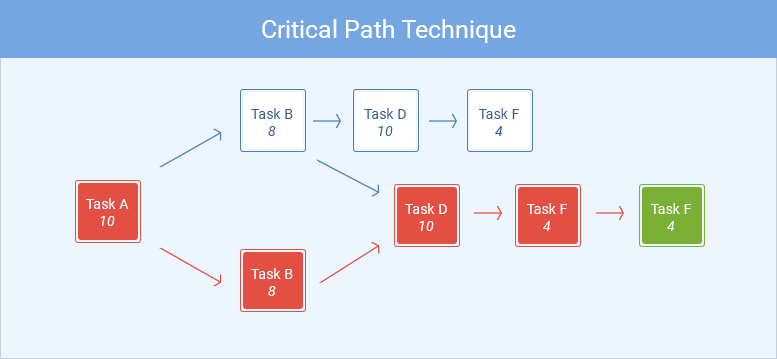
3. The Critical Chain Method
The Critical Chain Method (CCM) is a project management technique that helps you finish your projects faster without sacrificing quality. It requires you to:
- Identify the tasks that need to be completed for the project to finish.
- Determine the critical path, i.e., the sequence of tasks that must be completed on time to ensure you deliver the project on schedule.
- Factor in resource availability and uncertainty – the two variables that often cause projects to drag on longer than necessary.
- Shift part of the implicit reserves into so-called buffer activities. For example, a buffer set between the last activity in the chain and the overall project deadline ensures that delays won’t have an effect on the agreed delivery time.
In sum, this technique emphasizes prioritization, dependencies analysis, and optimization of time expenses. By taking into account the availability of resources and potential uncertainties, the CCM helps you create a realistic and achievable project schedule. This means that you’ll be better equipped to manage your time and resources effectively, resulting in a faster project completion time.
Best for: Complex projects with limited resources.
Agile Project Management Methodologies
Agile methodologies offer an iterative approach to managing projects. Originally developed for software projects, Agile is now widely used in marketing and advertising projects.
Agile teams easily adapt to changes, provide tangible results, and perform quality assurance, meaning less rework and improved quality.
The official Agile Manifesto, created in 2001, highlights four key values that apply to all Agile methodologies:
- Individuals and interactions over processes and tools
- Working software over comprehensive documentation
- Customer collaboration over contract negotiation
- Responding to change over following a plan
1. Agile Project Management Methodology
Agile project management is a structured, adaptive, iterative approach to business planning and managing work processes. It involves performing multiple activities simultaneously without any chronological, sequential dependencies. This way, it offers two significant advantages over traditional approaches.:
- You can quickly detect and fix unexpected issues
- You can introduce changes at any stage of the project. Other work processes will change dynamically
Best for: Projects that require a responsive and fast-paced approach and involve teams that boast strong communication and collaboration skills.
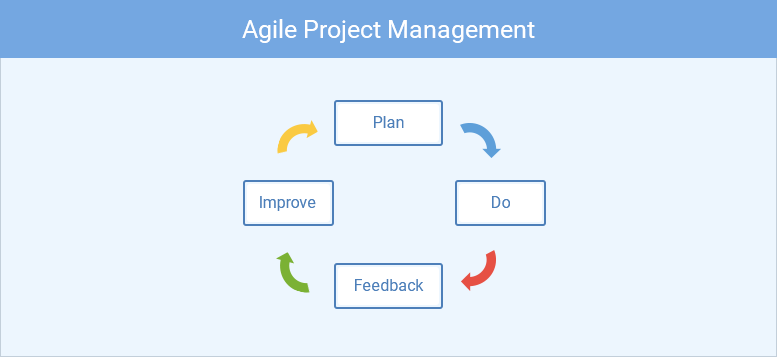
2. The Scrum Framework
With Scrum, your team works in fixed-length intervals called Sprints that include a sprint planning stage, sprint review, and daily standup meetings. It also has the following three clearly defined roles:
- Product Owner usually refers to a customer or other stakeholder who takes part in all development stages conveying the global vision and providing feedback.
- Scrum Master is the person responsible only for managing the project process, removing obstacles, and coaching their team through meetings or other venues.
- Scrum Team is a team with developed collaboration skills following a common goal.
Best for: Collaborative teams working on complex projects with changing requirements.
3. Kanban
Kanban is a visual system that helps teams manage work and workflow. It was originally used in manufacturing to optimize inventory levels, but it has since been adapted for software development and other industries.
In Kanban, work is represented on a Kanban board that consists of columns that track the workflow, from backlog to done. Each column has a set work-in-progress (WIP) limit, which ensures that the team doesn’t overload themselves with too much work at once.
The beauty of Kanban is that it promotes continuous delivery and encourages teams to focus on completing small chunks of work at a time. This not only leads to faster delivery times but also reduces the risk of errors and simplifies the debugging process.
Additionally, Kanban provides the team with a shared understanding of their work and progress, as everything is transparent and visible on the board. This promotes collaboration and ensures that everyone is aware of what’s going on.
Unlike Scrum, the Kanban approach doesn’t prescribe any deadlines or set other fixed time frames. There’s also no Kanban master to manage the processes – the entire team is responsible for the work delivery.
Best for: Collaborative teams that have lots of incoming tasks of varying priority and complexity.
4. Extreme Programming
Extreme Programming (XP) is a methodology that takes the “extreme” part of its name seriously. It’s all about embracing change and committing to continuous improvement in every aspect of software development.
XP was created in the late ’90s by Kent Beck, who was looking for a way to speed up the software development process without sacrificing quality. XP does this by using the four development processes (i.e., coding, testing, listening, and designing), a set of best software development practices, and values that all mix together to create a highly collaborative and flexible work environment.
Some of the core practices of XP include:
- Pair programming (where two developers work on the same code at the same time)
- Test-driven development (where tests are written before the code)
- Continuous integration (where code is integrated into the main branch several times a day)
But what really sets XP apart is its emphasis on communication and feedback. XP teams typically hold daily stand-up meetings, have an on-site customer who’s involved in the development process, and use a technique called “planning game” to prioritize work and set realistic goals.
Best for: Small teams developing engineering projects with dynamically changing requirements.
5. Adaptive Project Framework
Adaptive Project Framework (APF) is an iterative, client-focused, and adaptive approach to project planning. It grew from the assumption that most IT projects can’t be managed using traditional PM methods and was designed to help project managers respond to unexpected changes effectively.
APF includes the following five stages:
- Project scope – requires meaningful client involvement to establish the project’s goals, objectives, success criteria, risks, assumptions, obstacles, and requirements.
- Cycle plan – a high-planning stage where project managers establish tasks, their order, schedule, dependencies, and resource requirements.
- Cycle build – team commences its work while the manager adjusts the work scope, and records change requests and ideas for improvement.
- Client checkpoint – project team and their client review the results before starting the next APF cycle.
- Post-version review – project manager determines whether the business outcome was achieved, identifies improvements, and collects best practices.
Best for: Projects where “the goals are clearly known, but the solutions are not.”
Change Management Methodologies
Change management methodologies ensure a systematic approach to handling and implementing changes in an organization. They are designed to minimize the negative impact of change on a company’s workflow, culture, and overall performance while maximizing the desired positive outcomes.
Whether it’s a small-scale change or a large-scale transformation, change management methodologies provide a framework for managing change by identifying potential risks, engaging stakeholders, and creating a plan for successful implementation.
Now, let’s review some of the most popular change management approaches.
1. Event Chain Methodology
The Event Chain Methodology is an uncertainty modeling approach. It’s based on identifying relationships between project events and focuses on events that may affect project schedules.
It is considered a more effective approach to project scheduling than the Critical Path and Critical Chain methods. It is used to manage both expected and unexpected events that affect project planning.
The six major principles of the Event Chain Methodology include:
- Risk time and Status – external events may impact the project negatively or positively.
- The Chain of Events – a delay in one segment of the project will cause delays in other segments.
- The Monte Carlo Simulation – a mathematical technique that calculates probabilities of project risks.
- Critical Event Strings – event chains that are most likely to impact the project. Project managers need to identify these, to mitigate their potential negative impact.
- Performance tracking with Event Chains – project managers should update the results of the Monte Carlo simulation throughout the duration of the project.
- Event Chain Diagrams – visualize risks by showing relationships between events and tasks, and the impact of each.
Best for: Identifying expected and unexpected events that affect project planning in complex projects.
2. Extreme Project Management
Extreme Project Management (XPM) is a methodology that aims to tackle complex and high-risk projects. It takes a more flexible and adaptive approach to managing projects than traditional methodologies.
The idea behind XPM is to be reactive and adaptable to changing circumstances throughout the course of a project. It acknowledges that things can and will go wrong and that plans need to be adjusted accordingly.
So, what does XPM look like in action? Here are a few key characteristics:
- The team is empowered to make decisions: This means that the team has the authority and autonomy to make decisions that will impact the project. This is crucial for adapting to changing circumstances, as it allows the team to make decisions quickly and efficiently.
- The project is broken up into smaller chunks: XPM relies on a series of smaller, more manageable projects that are completed in phases. This allows for more frequent milestones and checkpoints, which allows the team to quickly identify and correct any issues that arise.
- Communication is key: XPM relies heavily on communication skills and the ability to collaborate effectively. The team needs to be able to work together closely and communicate frequently, in order to adapt to changes as they occur.
Best for: Complex projects with uncertain and unpredictable factors.
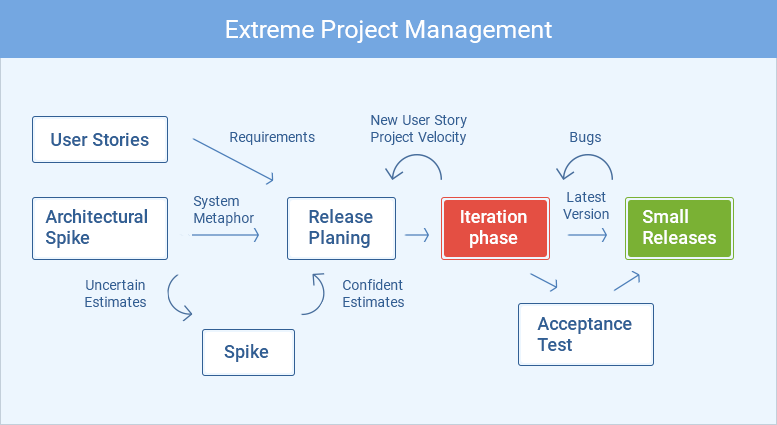
Other Project Management Methodologies
1. Rational Unified Process
Created half a century ago before Agile, the Rational Unified Process (RUP) is an iterative process framework designed for software development teams. It offers an iterative approach to project management that relies on product users’ feedback for planning future development stages and includes the following phases:
- Inception – risk assessment and resource allocation
- Elaboration – resource allocation and cost estimation
- Construction – development stage
- Transition v project delivery and final adjustments based on the end-user feedback
Best for: Software development projects where end-user satisfaction is the key requirement.
2. Program Evaluation & Review Technique
The Program Evaluation and Review Technique (PERT) is used to identify the time it takes to finish a particular task or activity. This, in turn, helps in scheduling and coordination, task delegation, and budget estimation.
To determine realistic estimates using this technique, managers create PERT charts, i.e., flowcharts that depict activity sequences inside the project. Chart nodes represent events that may include one or several tasks, and arrows show their sequence.
After that, managers calculate optimistic and pessimistic time, expected and most likely time. Other important metrics include possible slack (i.e., the task-level delay time) and critical path (i.e., the longest possible path from the start to the end of a task, an event, or a project).
Best for: Large and long-term projects with non-routine tasks and challenging requirements.
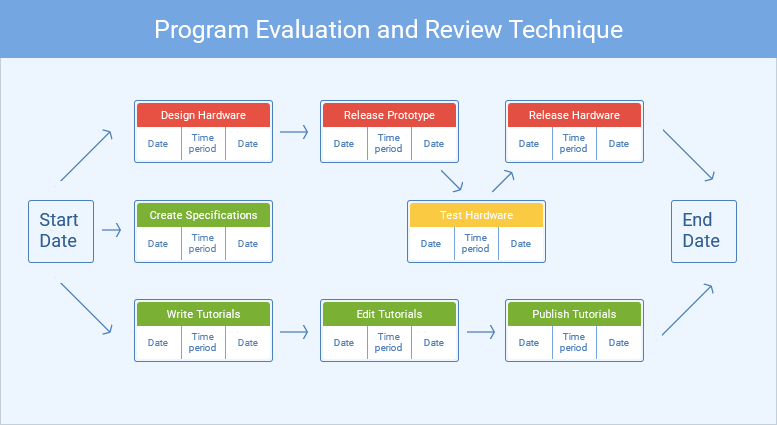
3. The PMBOK Method
A Guide to the Project Management Body of Knowledge (PMBOK) by the Project Management Institute (PMI) describes a structured approach to managing time, projects, resources, schedules, risks, and other business aspects. It includes the following five stages:
- Initiating – assessing and defining the scope and goals of the project.
- Planning – developing a workflow, establishing a more detailed scope, allocating resources, and building timetables.
- Executing – managing teams, monitoring timelines and resources, balancing stakeholder involvement.
- Controlling – tracking, reviewing, and regulating the progress.
- Closing – assessing project results, key strengths, and weaknesses.
The main strength of the book is that it provides a comprehensive range of 132 useful tools and techniques described or referred to.
Best for: Any type of project.
7 Efficiency-Boosting Project Management Tools
1. actiTIME
Key features:
- Time tracking
- Task management
- Billing & invoicing
- Reports
actiTIME is an all-in-one project management solution that provides a wealth of benefits to anyone looking to streamline their workflow, increase productivity, and get better results. It offers a range of tools to assist with project progress tracking:
- Time tracking to keep an eye on your team productivity, deadlines, and resource management.
- Kanban board to visualize project workflows and monitor task progress in real time.
- Visual charts to help you identify trends and analyze project performance.
With all of this information at your fingertips, you can easily see if everything goes as planned and make informed decisions about how to best allocate resources and get things done.
But that’s not all!
actiTIME helps to make evidence-based task estimates, allowing you to set realistic expectations for project completion timeframes. Besides, it enables you to keep tabs on staff-related project costs, so you can identify any areas where you’re overspending and make adjustments accordingly.
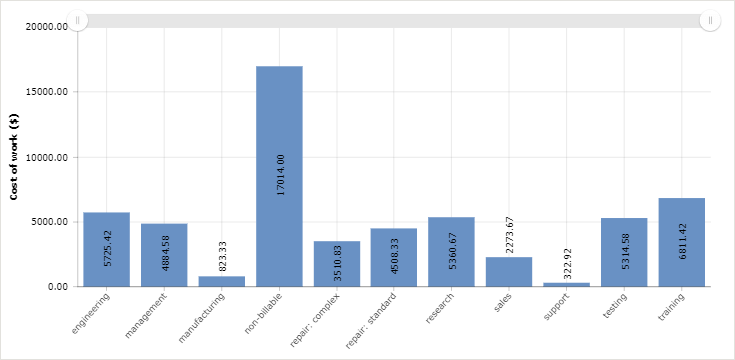
Last but not least, actiTIME can even help you bill clients accurately for the work that you do. With detailed time tracking data and the ability to create customized invoices, you can ensure that you’re getting paid what you’re worth for all of your hard work.
So if you’re looking to take your project management game to the next level, actiTIME is definitely worth checking out. Sign up for a free 30-day trial here and give it a go.
Best for: Both agile and traditional project management teams of any size.
2. Trello
Key features:
- Collaboration
- Boards & cards
- Checklists
- Calendar View
This simple project management tool has become a favorite among teams from all walks of life, and it’s easy to see why. It helps to keep projects organized, streamlined, and on track for success.
One of Trello’s biggest advantages is its flexibility. The tool’s Kanban-style board system allows you to customize your board layout to fit the needs of each project. You can choose from various board templates such as Scrum, Agile, and Waterfall, or create your card system from scratch. This way, you can adapt Trello to your team’s preferred way of working.
Trello is also great at simplifying communication and collaboration among team members. Each card has a space for comments, attachments, labels, and checklists, allowing team members to share feedback, ideas, and progress all in one location. This way, team members can quickly get up to speed, stay informed on project status updates, and work together in real time.
Best for: Project teams that prefer the simplicity and flexibility of the Kanban board.
3. Jira
Key features:
- Scrum & Kanban boards
- Roadmaps
- Reports
- Integrations
Jira is an online project management tool that helps teams to manage tasks, issues, and bugs throughout a project’s lifecycle. It allows you to comfortably track your projects’ progress and stay in the loop, even if you’re not in the same location as your team.
With such features as Scrum and Kanban boards, Gantt charts, and agile reporting, your project management life is about to get so much easier. You can also create custom workflows to tailor the tool to your project’s unique requirements, track team members’ workloads, and progress, and identify potential issues before they turn into big problems.
The best part?
Jira integrates with a bunch of other tools, like Confluence, Bitbucket, and actiTIME, allowing you to seamlessly move to other parts of your project management pipeline without switching between tools. This integration saves valuable time and reduces the risk of human error.
Best for: Software development teams.
4. ZenTao
Key features:
- Scrum
- Gantt charts
- Customizable workflows
- Risk management
ZenTao is no ordinary Scrum tool. It’s a project management powerhouse equipped with top-of-the-line features that make it a popular choice for organizations that want to achieve peak efficiency.
For starters, ZenTao offers a free open-source version with DevOps management and basic BI report functionality. But, if that’s not enough, the paid versions are equipped with customizable workflows, advanced reporting, and even risk management features.
As such, ZenTao offers two major components for effective project management – the Scrum tool and the Gantt chart. The former enables Agile teams to easily manage their projects using the Scrum methodology, while the latter provides an easy-to-understand view of the project schedule, allowing teams to easily identify dependencies, plan and manage resources, and track progress.
Best for: Software development teams that seek a custom project management solution or have a constrained budget.
5. Kanbanize
Key features:
- Kanban board
- OKRs
- Timelines
- Project dashboard
Kanbanize is an intuitive platform that helps teams collaborate, plan, and execute their work with ease. It offers a Kanban board to visualize the project’s status and allows everyone on the team to see what’s being worked on, what’s been completed, and what still needs to be done.
Besides, Kanbanize allows you to adhere to the OKR framework, which helps to set clear and measurable goals that align with the overall business objectives. The tool ensures that these goals are communicated and tracked effectively, giving your team a roadmap for success.
Best for: Teams that value visual project management and simple collaboration features.
6. GanttPro
Key features:
- Gantt charts
- Resource management
- Budget management
- Project templates
GanttPro is a project management tool that allows users to create, manage, and track projects with ease. It uses a Gantt chart, a visual representation of a project schedule, to help you keep track of project timelines and progress.
With GanttPro, you can assign tasks, set deadlines, and monitor progress all in one place. This eliminates the need for constant back-and-forth communication between team members, which can be a major time drain.
One of the coolest features of GanttPro is the drag-and-drop functionality, which makes it super easy to move tasks and deadlines around as needed. This is especially useful for projects that are prone to changes and updates, as it allows you to quickly adjust the schedule without having to start from scratch.
Best for: Medium-sized and large businesses looking for an all-in-one project management tool.
7. ResourceGuru
Key features:
- Gantt charts
- Resource management
- Budget management
- Project templates
ResourceGuru is an exceptional resource management tool that has been simplifying the lives of project managers and team leaders worldwide.
It lets you create and manage multiple projects with just a few clicks, set up custom project templates, and save them for future use. It offers intuitive resource scheduling functionality that enables you to see what tasks your team members are working on, when they are available, and even track their time off.
Besides, ResourceGuru’s reports allow managers to track resource utilization levels and forecast future capacity requirements. This way, it takes the guesswork out of managing project resources and deadlines.
Best for: Complex, resource-intensive projects.
Choose the Right Project Management Tools and Techniques
When evaluating the right project management methodology for your next project, here are a few factors to consider:
- Project focus (task activities or final product)
- Customer and stakeholder involvement
- Timeline flexibility
- Project budget
- Number and type of teams involved
- Required and available resources
- Resistance to change
- Rigidity of structure
- Project drivers and constraints
- Level of risks and the likelihood of occurrence
- Complexity of the project
If you feel overwhelmed by project management tools and techniques, we invite you to start with actiTIME’s free trial period (no credit card required).
With actiTIME, you can easily assign tasks to team members, track their progress, and monitor their time spent on each project. The software includes powerful reporting and analytics tools that provide valuable insights into team workload and project status. It allows you to make informed decisions and adjust resources as needed.
Learn more about actiTIME or request a product demo with our experts.






















































